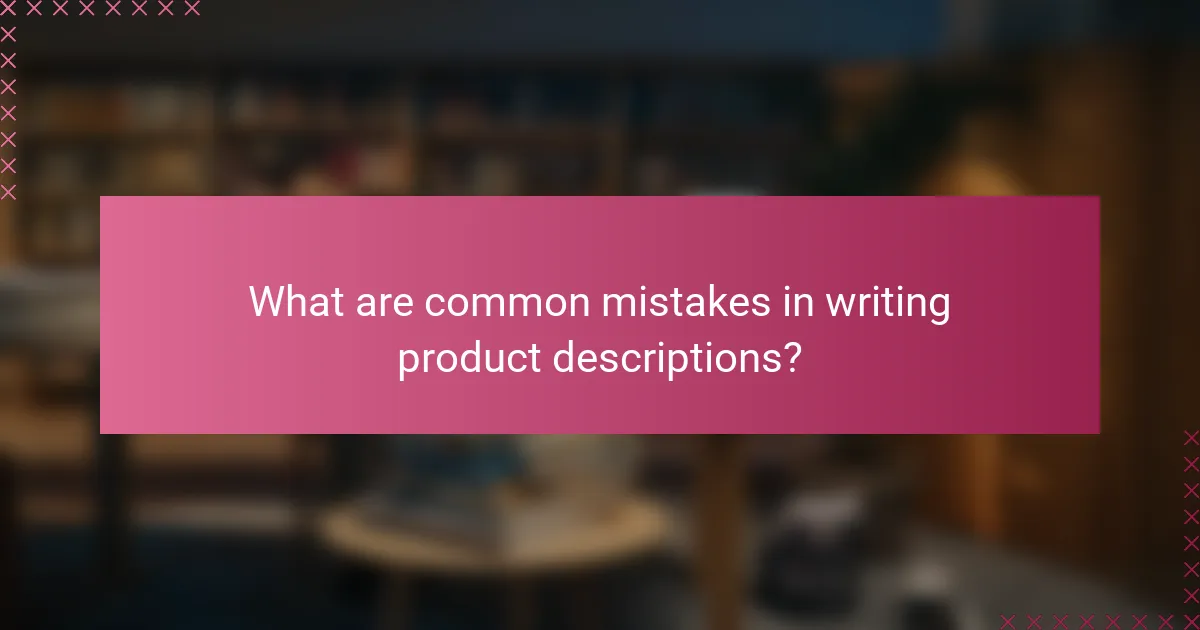Effective product descriptions are vital for enhancing e-commerce sales, as they provide potential customers with crucial information while persuading them to make a purchase. By combining clarity and persuasive elements, these descriptions highlight key features and benefits, fostering a deeper emotional connection with the target audience and ultimately driving higher conversion rates.

How can product descriptions enhance e-commerce sales?
Product descriptions are crucial for boosting e-commerce sales as they provide potential buyers with essential information and persuasive elements that encourage purchases. Well-crafted descriptions can clarify product benefits, address customer concerns, and ultimately lead to higher sales conversions.
Increased conversion rates
Effective product descriptions can significantly increase conversion rates by clearly communicating the value of a product. When customers understand how a product meets their needs or solves their problems, they are more likely to complete a purchase. Use persuasive language, highlight key features, and include calls to action to guide potential buyers toward making a decision.
Consider employing techniques such as bullet points for quick readability and emphasizing unique selling points. For instance, a description for a kitchen appliance might note its energy efficiency, ease of use, and warranty, appealing to environmentally conscious consumers.
Improved customer engagement
Engaging product descriptions can enhance customer interaction with your e-commerce site, leading to longer browsing times and increased likelihood of repeat visits. Descriptions that tell a story or evoke emotions can create a connection with the customer, making them more invested in the product.
Incorporate customer testimonials or user-generated content to further engage visitors. For example, a clothing retailer might include a brief story about how a dress was inspired by a specific event, making it more relatable and compelling for potential buyers.
Enhanced brand perception
Well-written product descriptions contribute to a positive brand perception by reflecting professionalism and attention to detail. A consistent tone and style across descriptions can reinforce brand identity, making it more memorable to customers.
To enhance brand perception, ensure that descriptions align with your overall branding strategy. For instance, a luxury brand should use sophisticated language and emphasize exclusivity, while a budget-friendly brand might focus on practicality and value. This alignment helps customers feel confident in their purchasing decisions and fosters brand loyalty.

What are the key elements of persuasive product descriptions?
Persuasive product descriptions are crafted to engage potential buyers by highlighting essential features, benefits, and emotional connections. Key elements include compelling headlines, emotional storytelling, and clear benefits and features that resonate with the target audience.
Compelling headlines
A compelling headline grabs attention and encourages further reading. It should be concise, engaging, and clearly convey the product’s main benefit or unique selling point. For example, instead of “New Coffee Maker,” use “Brew Barista-Quality Coffee at Home.”
To create effective headlines, consider using action verbs, numbers, or questions that spark curiosity. Avoid jargon and ensure the headline aligns with the product’s overall message.
Emotional storytelling
Emotional storytelling connects with customers on a personal level, making the product more relatable. Share narratives that illustrate how the product fits into the customer’s life or solves a problem. For instance, describe a family gathering enhanced by your kitchenware.
Incorporate sensory details and vivid imagery to evoke feelings. This approach not only captivates the audience but also helps them envision the product’s impact on their lives.
Clear benefits and features
Highlighting clear benefits and features is crucial for helping customers understand what they gain from the product. Focus on how the product improves their life, saves time, or offers value. Use bullet points for easy readability, such as listing key features like “Energy-efficient,” “Compact design,” or “User-friendly interface.”
Be specific about the benefits. Instead of saying “high quality,” explain how the materials used enhance durability or performance. This clarity helps customers make informed purchasing decisions and reduces the likelihood of returns.

How does clarity impact product descriptions?
Clarity in product descriptions is essential as it directly influences customer understanding and purchasing decisions. Clear descriptions help customers quickly grasp product features, benefits, and usage, reducing the likelihood of confusion and returns.
Reduced customer confusion
When product descriptions are clear and straightforward, customers can easily understand what they are buying. This reduces the chances of misinterpretation, which can lead to dissatisfaction or returns. For example, using simple language and avoiding jargon can help ensure that all potential buyers, regardless of their expertise, comprehend the product details.
To enhance clarity, consider using bullet points for key features and benefits. This format allows customers to scan information quickly, making it easier for them to make informed decisions. Aim for concise descriptions that focus on the most relevant aspects of the product.
Increased trust and credibility
Clear product descriptions foster trust and credibility between the seller and the customer. When descriptions are transparent and informative, customers feel more confident in their purchase, knowing they have all the necessary information. This trust can lead to repeat purchases and positive reviews.
To build credibility, ensure that all claims made in the product description are accurate and verifiable. Avoid exaggerations and provide specifications that align with customer expectations. Including customer testimonials or ratings can also enhance trust, as potential buyers see that others have had positive experiences with the product.

What SEO strategies should be applied to product descriptions?
Effective SEO strategies for product descriptions enhance visibility in search engines and improve user engagement. Key tactics include keyword optimization, schema markup, and ensuring mobile-friendly formatting.
Keyword optimization
Keyword optimization involves researching and incorporating relevant terms that potential customers use to search for products. Aim for a mix of short-tail and long-tail keywords to capture a broader audience while targeting specific queries.
Place primary keywords in critical areas such as the product title, headings, and the first 100 words of the description. Avoid keyword stuffing; instead, focus on natural language that flows well and provides value to the reader.
Use of schema markup
Schema markup is a structured data format that helps search engines understand the content of your product pages better. Implementing schema can enhance search results with rich snippets, which may include product ratings, prices, and availability.
To apply schema markup, use JSON-LD format, which is recommended by Google. Tools like Google’s Structured Data Markup Helper can assist in generating the necessary code. Ensure that the markup is accurate and reflects the actual content to avoid penalties.
Mobile-friendly formatting
Mobile-friendly formatting ensures that product descriptions are easily readable on smartphones and tablets. With a significant portion of online shopping occurring on mobile devices, this is crucial for user experience and SEO.
Use responsive design techniques, such as flexible layouts and scalable images, to adapt to various screen sizes. Keep paragraphs concise, utilize bullet points for key features, and ensure that buttons are easily clickable. Regularly test your site on different devices to maintain optimal performance.

How can businesses measure the effectiveness of product descriptions?
Businesses can measure the effectiveness of product descriptions through various methods, including analytics tracking, customer feedback, and A/B testing. These approaches provide insights into how well descriptions engage customers and drive conversions.
Analytics tracking
Analytics tracking involves monitoring key performance indicators (KPIs) such as page views, bounce rates, and conversion rates. By analyzing these metrics, businesses can determine which product descriptions attract and retain customer interest.
For example, if a product description has a high bounce rate, it may indicate that the content is not resonating with visitors. Tools like Google Analytics can help businesses set up tracking for specific product pages and analyze user behavior effectively.
Customer feedback
Customer feedback is crucial for understanding the impact of product descriptions. Businesses can gather insights through surveys, reviews, and direct inquiries to assess how descriptions influence purchasing decisions.
Encouraging customers to leave feedback on product pages can provide valuable information. For instance, if multiple customers mention that a description lacks clarity, it may be time to revise the content to enhance understanding and appeal.
A/B testing results
A/B testing involves creating two versions of a product description to see which one performs better. By randomly showing different descriptions to visitors, businesses can measure engagement and conversion rates to identify the more effective option.
For example, a business might test a description that emphasizes features against one that highlights benefits. Analyzing the results can reveal which approach resonates more with the target audience, allowing for data-driven decisions in future content creation.

What are common mistakes in writing product descriptions?
Common mistakes in writing product descriptions include vague language, lack of detail, and failure to address customer needs. These errors can lead to poor engagement and lower sales, as potential buyers may not fully understand the product or its benefits.
Being too vague
Vagueness in product descriptions can confuse customers and diminish their interest. Instead of using generic terms, focus on specific features and benefits that clearly convey what the product offers. For instance, instead of saying “high-quality material,” specify “made from durable, water-resistant nylon.”
To avoid vagueness, use descriptive adjectives and precise measurements. For example, instead of “large,” use “30-inch” to give a clear idea of size. This clarity helps customers visualize the product and understand its value.
Neglecting SEO
Neglecting SEO in product descriptions can limit visibility on search engines. Incorporate relevant keywords naturally within the text to improve search rankings. Research popular search terms related to your product and include them in the title, headings, and body.
Additionally, consider using long-tail keywords that reflect specific customer queries. For example, instead of just “shoes,” use “men’s waterproof hiking shoes.” This targeted approach can attract more qualified traffic to your product page.
Ignoring the target audience
Ignoring the target audience can lead to descriptions that fail to resonate with potential buyers. Understand who your customers are and tailor your language and tone accordingly. For example, a tech-savvy audience may appreciate detailed specifications, while a general audience may prefer straightforward benefits.
To connect with your audience, use language that reflects their interests and needs. Consider creating buyer personas to guide your writing. This strategic approach ensures that your product descriptions speak directly to the people most likely to purchase.
Overloading with information
Overloading product descriptions with excessive information can overwhelm customers and lead to decision fatigue. Focus on the most important features and benefits, presenting them in a clear and concise manner. Use bullet points for easy readability and to highlight key aspects.
Limit the length of your descriptions to maintain engagement. Aim for a few short paragraphs or a brief list of features, ensuring that essential information is easily accessible without unnecessary detail.
